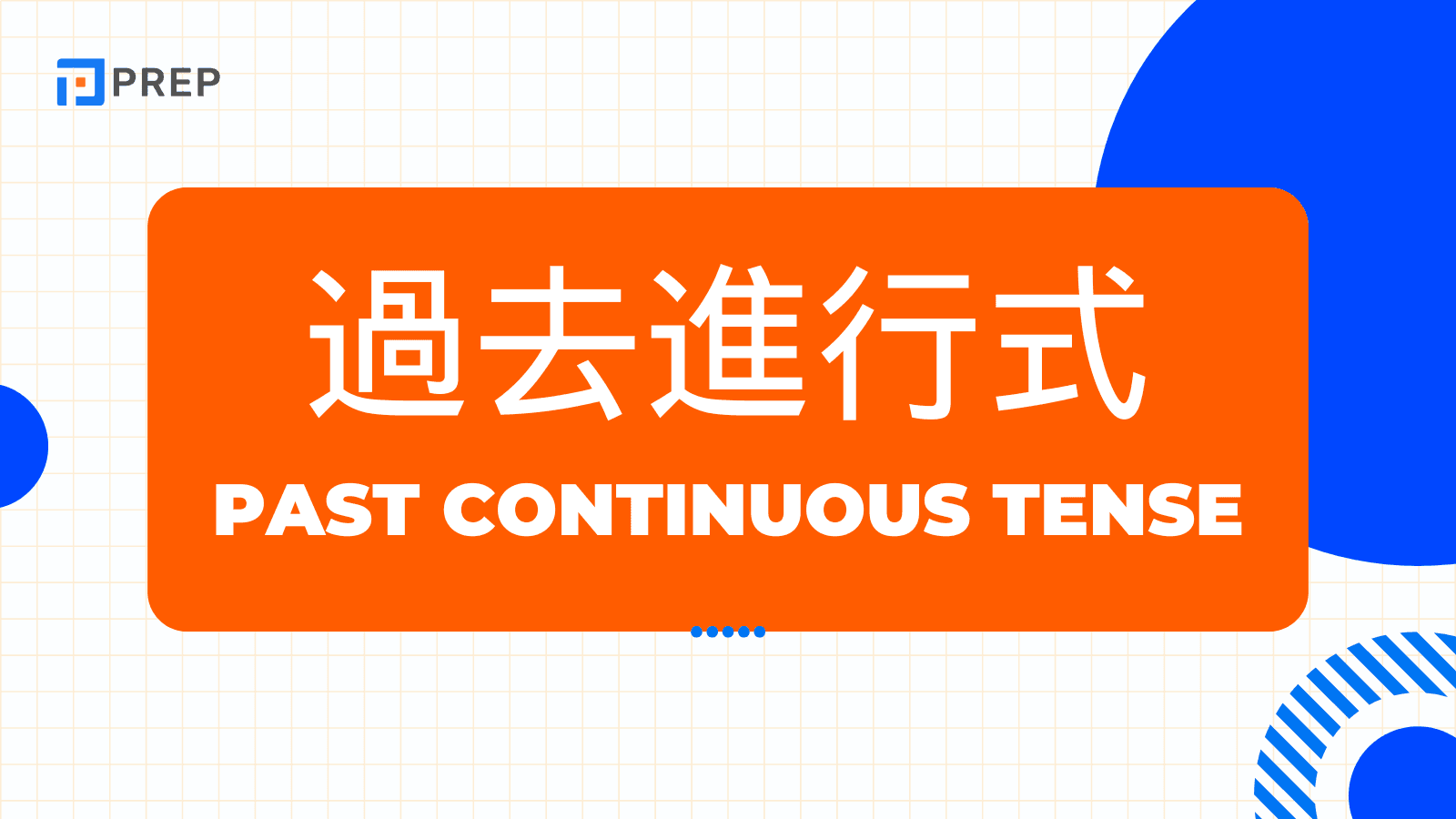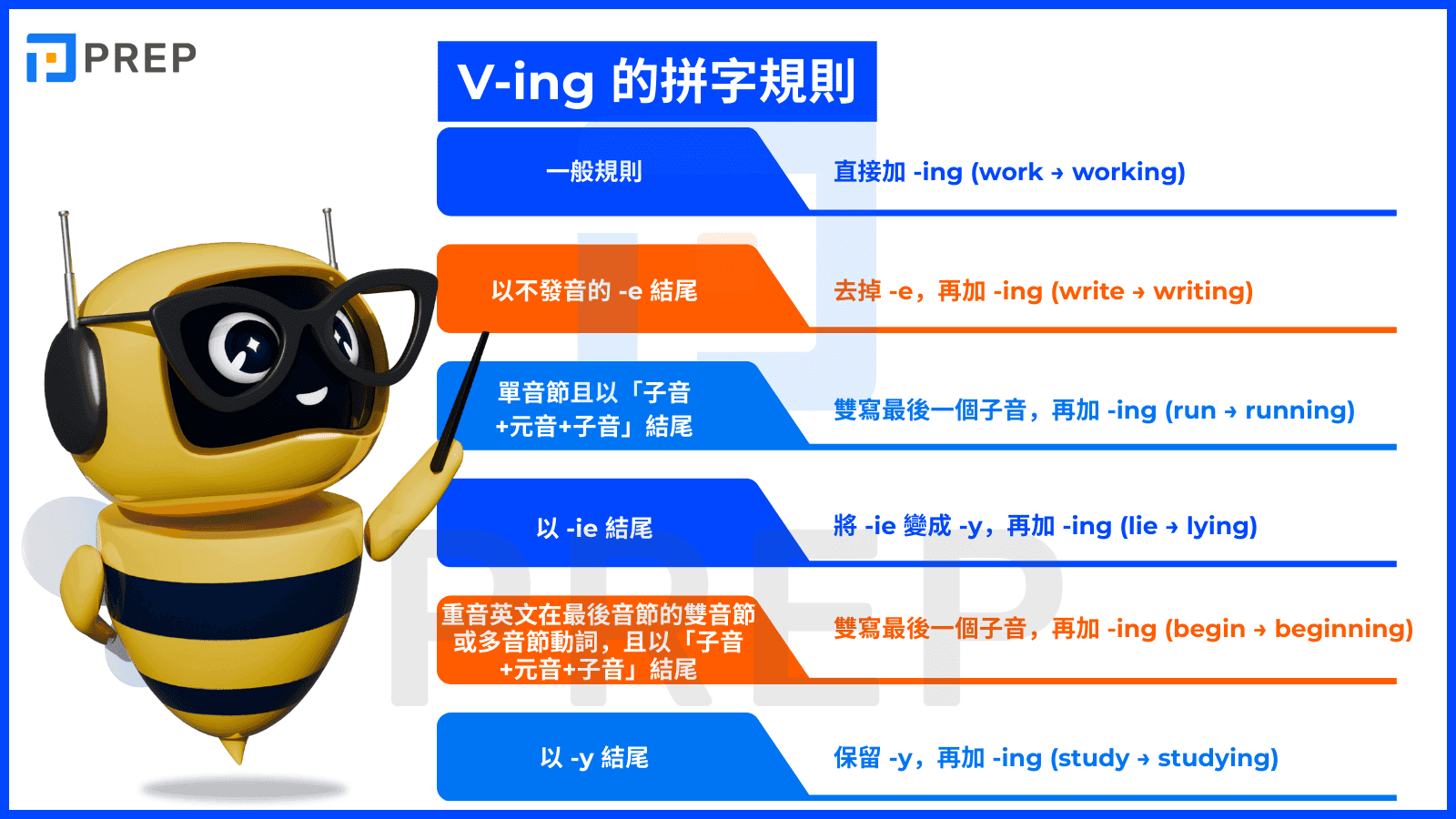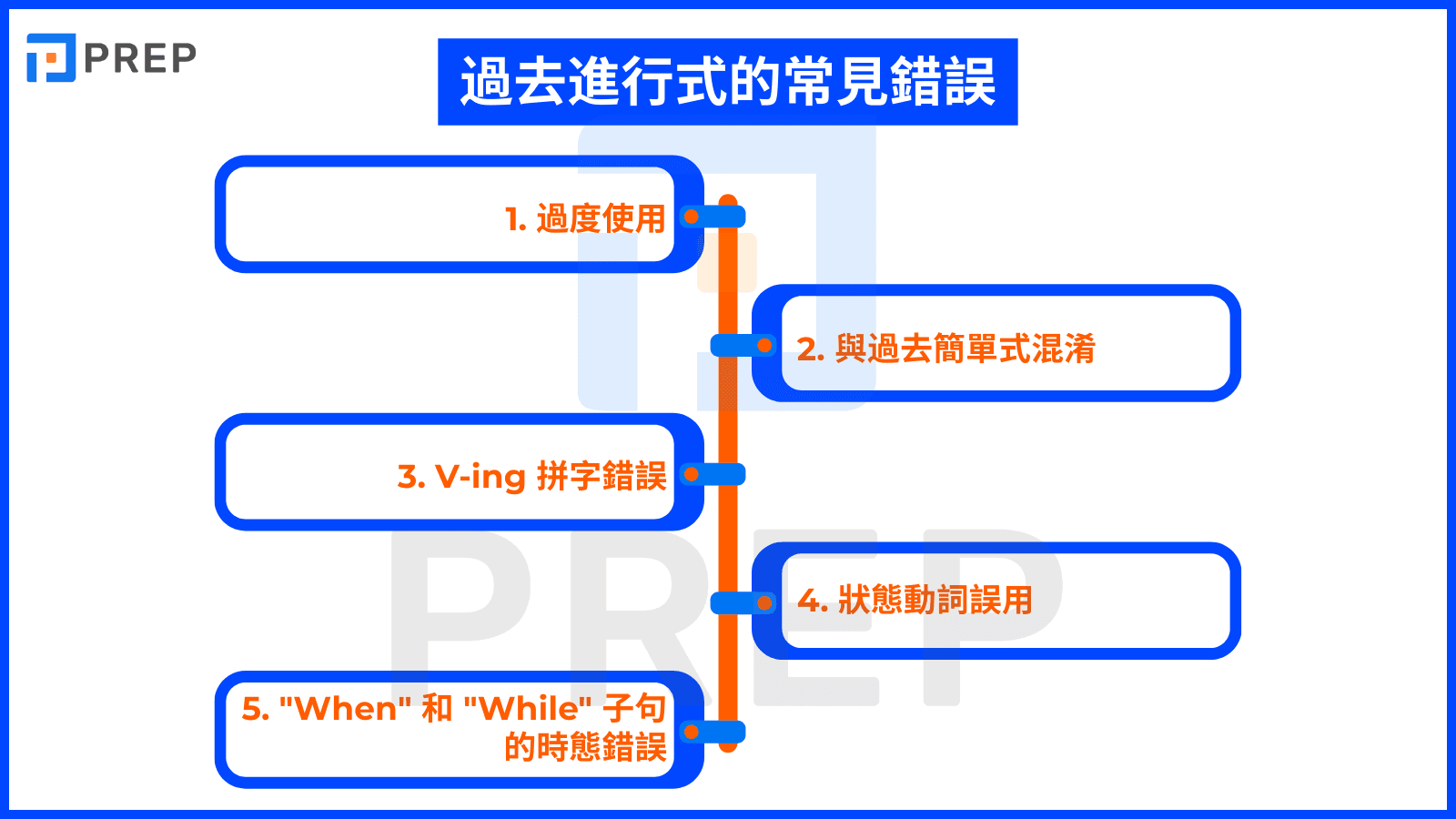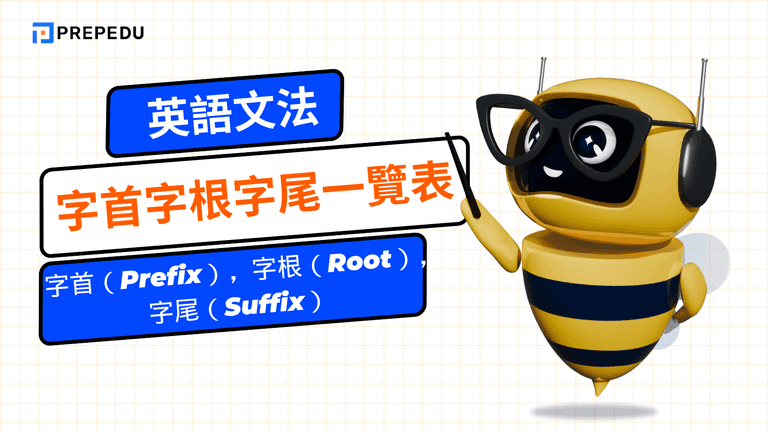英語過去進行式 (Past Continuous Tense): 定義、句法、用法、常見錯誤和練習題
您是否曾經嘗試描述過去正在發生的事情,卻不確定該如何準確表達?英語過去進行式(Past Continuous Tense)正是解決這個語言難題的關鍵。這個時態能讓您的敘述更加生動、立體,讓聽眾彷彿能看見過去那一刻的畫面—正在下雨的傍晚、專注工作的同事、嬉戲的孩童。掌握這個時態,您的英語表達將更加精準。
過去進行式是表達「過去某個時間點正在進行的動作」的時態,由「was/were + 動詞ing形式」構成。這個時態在敘述故事、描述場景和表達被打斷的動作時尤為重要,是英語學習者必須熟練掌握的基本時態之一。
過去進行式的精妙之處在於它能創造時間維度的層次感。與表示單純已完成動作的過去簡單式不同,過去進行式為我們提供了一個「窗口」,讓我們能夠看到動作正在進行的過程。想象一下:「昨天晚上八點,我正在讀書(I was reading a book at 8pm last night.)」—這句話立即在聽者腦海中創造了一個特定時刻的畫面。
這個時態有多種用法:描述過去特定時間點的動作(At midnight, the baby was sleeping.);表達兩個同時發生的動作(While I was cooking, she was setting the table.);描述被另一動作打斷的持續動作(I was taking a shower when the phone rang.);或者設定故事的背景(The sun was shining and birds were singing...)。
值得注意的是,過去進行式與頻率副詞如「always」、「constantly」連用時,常帶有抱怨或讚嘆的情感色彩(He was always complaining!)。而且,並非所有動詞都適合用於進行式—那些表示狀態而非動作的「狀態動詞」通常不使用進行式形式。
本文將詳細探討過去進行式的定義、句型結構、各種用法、與狀態動詞的關係,以及常見錯誤。通過豐富的例句和練習題,您將能夠準確識別何時使用過去進行式,避免常見錯誤,並在各種情境中靈活運用這個時態,使您的英語表達更加地道流暢。
準備好探索過去進行式的奧秘了嗎?讓PREP一起深入瞭解這個時態,讓您的英語表達更加精準生動!

I. 什麼是過去進行式?
1. 過去進行式的定義與核心概念
過去進行式(Past Continuous Tense)表示在過去某個特定時間點或時間段內正在進行或持續的動作。這個過去式英文態能夠創造出過去事件的動態畫面,讓敘述更加生動。
當我們使用過去進行式時,我們實際上是在強調動作的進行過程,而非結果。這個時態常常用來構建場景,描述背景,或說明被另一動作打斷的行為。
例句:
-
I was reading a book when you called. (你打電話來時,我正在讀書。)
-
They were playing tennis at 3pm yesterday. (昨天下午三點,他們正在打網球。)
-
She was cooking dinner while I was cleaning the house. (當我正在打掃房子時,她正在做晚餐。)

2. 過去進行式的時間軸
過去進行式在時間軸上表現為過去某一時段內持續進行的動作。與過去簡單式(表示已完成的動作)不同,過去進行式強調的是動作的持續性和未完成性。
時間軸上,過去進行式英文可以呈現為:
-
在過去特定時間點正在進行的動作
-
在過去某段時間內持續的動作
-
被另一動作(通常以過去簡單式表達)打斷的動作

II. 過去進行式的基本句型結構
現在我們已經了解了過去進行式的基本概念和時間軸特性,接下來讓我們深入探討其句型結構。掌握過去進行式的三種基本形式—肯定句、否定句和疑問句—對於靈活運用這個時態至關重要。

1. 肯定句 (Affirmative)
過去進行式英文肯定句的基本結構是:
主詞 + was/were + 動詞-ing
|
人稱 |
助動詞 |
動詞-ing形式 |
過去進行式例句 |
|
I |
was |
V-ing |
I was studying when you called. (你打電話時,我正在讀書。) |
|
You |
were |
V-ing |
You were sleeping at midnight. (午夜時分,你正在睡覺。) |
|
He/ She/ It |
was |
V-ing |
She was cooking dinner. (她正在做晚餐。) |
|
We |
were |
V-ing |
We were watching TV at 8pm. (晚上八點,我們正在看電視。) |
|
You (複數) |
were |
V-ing |
You were waiting for the bus. (你們正在等公車。) |
|
They |
were |
V-ing |
They were talking loudly. (他們正在大聲交談。) |
2. 否定句 (Negative)
過去進行式否定句的基本結構是:
主詞 + was/were + not + 動詞-ing
|
人稱 |
否定形式 |
動詞-ing形式 |
過去進行式例句 |
|
I |
was not (wasn't) |
V-ing |
I wasn't sleeping at 10pm. (晚上十點,我沒有在睡覺。) |
|
You |
were not (weren't) |
V-ing |
You weren't studying yesterday. (昨天,你沒有在讀書。) |
|
He/ She/ It |
was not (wasn't) |
V-ing |
He wasn't working on Sunday. (星期日,他沒有在工作。) |
|
We |
were not (weren't) |
V-ing |
We weren't watching the movie. (我們沒有在看那部電影。) |
|
You (複數) |
were not (weren't) |
V-ing |
You weren't listening to me. (你們沒有在聽我說話。) |
|
They |
were not (weren't) |
V-ing |
They weren't playing basketball. (他們沒有在打籃球。) |
3. 疑問句 (Interrogative)
過去進行式疑問句的基本結構是:
Was/Were + 主詞 + 動詞-ing?
|
疑問句類型 |
結構 |
過去進行式例句 |
|
一般疑問句 |
|
|
|
Wh- 疑問句 |
|
|
4. V-ing 的拼字規則
動詞變成現在分詞(V-ing)形式時,需要遵循一些特定的拼字規則:
|
規則類型 |
規則說明 |
例子 |
|
一般規則 |
直接加 -ing |
|
|
以不發音的 -e 結尾 |
去掉 -e,再加 -ing |
|
|
單音節且以「子音+元音+子音」結尾 |
雙寫最後一個子音,再加 -ing |
|
|
以 -ie 結尾 |
將 -ie 變成 -y,再加 -ing |
|
|
重音英文在最後音節的雙音節或多音節動詞,且以「子音+元音+子音」結尾 |
雙寫最後一個子音,再加 -ing |
|
|
以 -y 結尾 |
保留 -y,再加 -ing |
|

理解上述結構將有助於您在許多不同的語境中正確使用過去進行式英文,接下來我們將探討這個時態的各種用法。
III. 過去進行式用法
應用上述結構,我們可以在多種不同情況下使用英語過去進行式。

1. 描述過去特定時間點正在發生的動作
過去進行式常用於描述在過去某個特定時間點正在進行的動作,強調動作的持續性。這種用法通常會搭配特定的時間標記。例句:
-
At 8pm last night, I was having dinner with my friends. (昨晚八點,我正在和朋友共進晚餐。)
-
This time yesterday, they were flying to Tokyo. (昨天這個時候,他們正在飛往東京。)
-
When the clock struck twelve, the children were sleeping peacefully. (當時鐘敲響十二下時,孩子們正在安睡。)
-
At 3pm yesterday, Mark was presenting his project to the clients. (昨天下午三點,馬克正在向客戶展示他的專案。)
2. 描述兩個或多個同時發生的動作
過去進行式可用於描述在過去同一時間內發生的兩個或多個持續性動作,通常搭配 "while" 或 "as" 連接。例句:
-
While I was cooking dinner, my husband was setting the table. (當我在做晚餐時,我丈夫正在擺桌子。)
-
The children were playing in the garden while their parents were chatting in the living room. (當父母在客廳聊天時,孩子們正在花園裡玩耍。)
-
As she was walking to school, she was listening to music on her headphones. (當她走路去學校時,她正戴著耳機聽音樂。)
-
The teacher was explaining the lesson while the students were taking notes. (老師正在解釋課程,而學生們正在做筆記。)
-
While it was raining outside, we were watching a movie indoors. (當外面正在下雨時,我們在室內看電影。)
3. 描述一個被中斷的動作
過去進行式常與過去簡單式搭配使用,描述一個正在進行的動作被另一個突發動作所中斷的情況。這是過去進行式最常見的用法之一。例句:
-
I was taking a shower when the phone rang. (電話響起時,我正在洗澡。)
-
She was sleeping when the earthquake happened. (地震發生時,她正在睡覺。)
-
They were having a picnic when it started to rain. (開始下雨時,他們正在野餐。)
-
The baby was smiling when I took the photo. (我拍照時,嬰兒正在微笑。)
-
We were watching TV when the power went out. (停電時,我們正在看電視。)
"When" 和 "While" 引導子句的時態用法:
|
連接詞 |
主要用法 |
搭配時態 |
例句 |
|
When |
表示一個動作發生在另一個動作進行期間 |
When + 過去簡單式,過去進行式 |
When I arrived, they were having dinner. (我到達時,他們正在吃晚餐。) |
|
While |
表示兩個動作同時進行 |
While + 過去進行式,過去進行式/過去簡單式 |
While I was cooking, he was setting the table. (當我在煮飯時,他正在擺桌子。) |
4. 描述過去的背景或情境
過去進行式常用於描述故事或敘述的背景情境,為主要事件設置場景。例句:
-
The sun was shining and birds were singing when we arrived at the park. (當我們到達公園時,太陽正照耀著,鳥兒正在歌唱。)
-
When I entered the classroom, some students were chatting, others were reading, and a few were writing notes. (當我進入教室時,一些學生正在聊天,其他人正在閱讀,還有幾個正在寫筆記。)
-
It was raining heavily, and the wind was blowing fiercely as the storm approached. (暴風雨來臨時,雨正在傾盆而下,風正猛烈地吹著。)
-
The city was preparing for the festival when we visited last year. (去年我們參觀時,這個城市正在準備節日活動。)
5. 描述過去的 (暫時性) 習慣
過去進行式可以用來描述在過去某段時間內的暫時性習慣或反覆發生的動作,尤其是帶有些微負面或不尋常的含義時。例句:
-
Last summer, I was jogging every morning before sunrise. (去年夏天,我每天日出前都在慢跑。)
-
During college, she was always studying until midnight. (在大學期間,她總是讀書到午夜。)
-
When I lived in Paris, I was taking French classes three times a week. (當我住在巴黎時,我每週上三次法語課。)
以下表格詳細比較了過去進行式與 "used to" 結構在描述過去習慣時的不同特點、用法與應用場景:
|
比較項目 |
過去進行式 (was/were + V-ing) |
Used to + 動詞原形 |
|
基本定義 |
表示在過去特定期間內重複發生的暫時性動作或習慣 |
表示過去長期、規律的習慣或狀態,現在已不再持續 |
|
時間範圍 |
通常限於較短、明確的時間段(如:去年夏天、大學期間) |
泛指過去較長一段時間,無明確界限(如:小時候、年輕時) |
|
持續性質 |
暫時性、臨時性的習慣 |
長期、穩定的習慣或狀態 |
|
現在狀態暗示 |
不清楚現在是否仍有此習慣 |
明確暗示現在已不再有此習慣或狀態 |
|
情感色彩 |
常與頻率副詞 (always, constantly) 連用表示抱怨或讚嘆 |
相對中性,強調變化,有時帶有懷舊感 |
|
適用情境 |
描述特定時期內的行為模式;表達對重複行為的情感反應 |
描述人生階段的習慣;強調與現在的對比;講述生活變化 |
|
常見搭配詞 |
last summer, during college, in 2010, at that time, back then |
when I was young, as a child, in my twenties, years ago |
|
例句 1 |
Last summer, I was jogging every morning before sunrise.(去年夏天,我每天日出前都在慢跑。) |
I used to jog every morning, but now I prefer yoga.(我以前每天早上都慢跑,但現在我更喜歡瑜伽。) |
6. 與 "always," "constantly," "forever" 連用,表達抱怨、不滿或讚嘆
過去進行式與頻率副詞如 "always," "constantly," "forever" 連用時,通常表達對過去重複發生動作的抱怨、不滿或讚嘆。例句:
-
She was always complaining about the weather. (她總是抱怨天氣。) - 抱怨
-
He was constantly interrupting our conversation. (他不斷地打斷我們的談話。) - 不滿
-
The children were forever asking questions. (孩子們總是不停地問問題。) - 可能是讚嘆或輕微抱怨
-
My grandmother was always baking delicious cookies for us. (我奶奶總是為我們烤美味的餅乾。) - 讚嘆
這類用法中,動詞的情感色彩:
|
情感色彩 |
常用動詞 |
|
負面 |
complain (抱怨), interrupt (打斷), forget (忘記), lose (丟失) |
|
中性 |
talk (談話), ask (詢問), try (嘗試), call (打電話) |
|
正面 |
help (幫助), support (支持), praise (讚揚), encourage (鼓勵) |
V. 過去進行式與狀態動詞
1. 狀態動詞的定義與分類
狀態動詞(State Verbs)是指表示狀態、情況、感覺、思想等非動作的動詞,而非表示動作或過程。這些動詞描述的是靜態的、持續的狀態,而非動態的行為。狀態動詞主要分為以下幾類:
-
感知動詞:see, hear, smell, taste, feel, notice, recognize
-
情感動詞:love, hate, like, dislike, prefer, adore, care, mind
-
認知動詞:know, understand, believe, think, remember, forget, mean, realize
-
擁有動詞:have, own, possess, belong to, owe, contain, consist of, include
-
存在動詞:be, exist, appear, seem, look, sound
-
其他狀態動詞:cost, need, matter, depend, weigh, measure, require, deserve

一般而言,狀態動詞不使用進行式,包括過去進行式,因為它們描述的是狀態而非動作,沒有「進行」的概念。錯誤地將狀態動詞用於進行式是英語學習者常犯的錯誤之一。
2. 例外情況:某些狀態動詞在特定情境下 可以 用進行式
某些狀態動詞在表達特定含義時,可以使用進行式形式,這時它們通常表示暫時的狀態或動作的過程,而非永久的狀態。例句:
-
I was thinking about the solution to the problem. (我正在思考這個問題的解決方案。) → 解釋:這裡的 "think" 表示主動思考的過程,而非單純的想法。
-
She was having lunch with her colleagues. (她正在和同事吃午餐。) → 解釋:這裡的 "have" 表示「吃」的動作,而非擁有。
-
The soup was tasting better after I added some salt. (加了些鹽後,湯的味道更好了。) → 解釋:這裡的 "taste" 表示品嚐的過程,強調變化。
-
The new perfume was smelling wonderful. (這款新香水聞起來很香。) → 解釋:這裡的 "smell" 強調的是感官體驗的過程。
-
He was being very rude at the party. (他在派對上表現得很粗魯。) → 解釋:這裡的 "be" 表示暫時的行為或表現,而非永久的特質。
VI. 辨識英語過去進行式的標誌
過去進行式通常與特定的時間標記連用,這些標記可以幫助我們辨識句子使用的是過去進行式。
|
時間標記類型 |
公式/結構 |
例句 |
|
特定時間點 |
At + 時間 (8pm, noon, midnight) |
At 10pm last night, I was watching a movie. (昨晚十點,我正在看電影。) |
|
特定日期時間 |
On + 日期 + at + 時間 |
On March 15th at 3pm, we were having a meeting. (在3月15日下午3點,我們正在開會。) |
|
年份中的時間 |
In + 年份 |
In 2010, she was living in New York. (2010年,她住在紐約。) |
|
過去時段 |
During + 時段 |
During the summer, the children were swimming every day. (在夏季,孩子們每天都在游泳。) |
|
同時性標記 |
While, As, When |
While I was cooking, the phone rang. (當我在煮飯時,電話響了。) |
|
特定過去時刻 |
This time + 過去時間 |
This time yesterday, I was traveling to Taipei. (昨天這個時候,我正在前往台北。) |
|
持續時段 |
All day/ morning/ night + 過去時間 |
All day yesterday, it was raining. (昨天一整天都在下雨。) |
VII. 過去進行式的常見錯誤

1. 過度使用
很多英語學習者傾向於過度使用過去進行式,尤其是在應該使用過去簡單式的情況下。
-
❌錯誤例句:I was finishing my homework last night. (我昨晚完成了我的家庭作業。)
✅正確例句:I finished my homework last night. (我昨晚完成了我的家庭作業。) → 解釋:如果強調的是完成的事實,而非過程,應使用過去簡單式。
-
❌錯誤例句:She was buying a new car last week. (她上週買了一輛新車。)
✅正確例句:She bought a new car last week. (她上週買了一輛新車。) → 解釋:購買行為是一個完成的動作,除非特別強調購買過程,否則應使用過去簡單式。
2. 與過去簡單式混淆
過去進行式和過去簡單式的適用場景常常讓學習者感到困惑。
|
情境 |
錯誤例句 |
正確例句 |
解釋 |
|
已完成的動作 |
I was reading the whole book yesterday. |
I read the whole book yesterday. |
「讀完整本書」是已完成的動作,應用過去簡單式。 |
|
連續發生的動作 |
While I was walking to school, I was seeing my friend. |
While I was walking to school, I saw my friend. |
「看到朋友」是瞬間動作,應用過去簡單式;「走路去學校」是持續動作,用過去進行式。 |
|
被中斷的動作 |
When the phone rang, I answered it. |
When the phone rang, I was taking a shower. |
主要動作「洗澡」被「電話響」中斷,應用過去進行式;中斷的動作「電話響」用過去簡單式。 |
3. V-ing 拼字錯誤
形成動詞的 V-ing 形式時,常見的拼字錯誤包括:
-
忘記雙寫字尾子音:runing (錯) → running (對)
-
錯誤保留字尾 -e:writeing (錯) → writing (對)
-
錯誤變換 -ie 結尾:lieing (錯) → lying (對)
-
錯誤處理重音在末音節的多音節詞:begining (錯) → beginning (對)
-
不必要地雙寫子音:travellling (錯) → traveling (對)(美式拼法)或 travelling (對)(英式拼法)
4. 狀態動詞誤用
誤用狀態動詞的過去進行式是常見錯誤。
-
❌錯誤例句:I was knowing the answer. (我當時知道答案。)
✅正確例句:I knew the answer. (我知道答案。) → 解釋:know 是狀態動詞,通常不用於進行式。
-
❌錯誤例句:She was owning three cars. (她擁有三輛車。)
✅正確例句:She owned three cars. (她擁有三輛車。) → 解釋:own 是狀態動詞,表示擁有關係,通常不用於進行式。
5. "When" 和 "While" 子句的時態錯誤
使用 "when" 和 "while" 引導的子句時,時態選擇常出錯。
-
❌錯誤例句:When I was cooking dinner, my husband was coming home. (當我在做晚餐時,我丈夫回家了。)
✅正確例句:When I was cooking dinner, my husband came home. (當我在做晚餐時,我丈夫回家了。) → 解釋:「回家」是瞬間動作,應用過去簡單式;「做晚餐」是持續動作,用過去進行式。
-
❌錯誤例句:While the teacher explained the problem, the students were taking notes. (當老師解釋問題時,學生們正在做筆記。)
✅正確例句:While the teacher was explaining the problem, the students were taking notes. (當老師正在解釋問題時,學生們正在做筆記。) → 解釋:after "while" 連接的動作通常是持續性的,應用過去進行式。
VIII. 綜合練習:掌握過去進行式
1. 選擇題 (Multiple Choice)
-
What _____ you _____ at 8pm last night? a) was / doing b) were / doing c) was / do d) were / do
-
While she _____ dinner, the phone _____. a) cooked / was ringing b) was cooking / rang c) was cooking / was ringing d) cooked / rang
-
I _____ to music when my friend _____ me. a) listened / was calling b) was listening / called c) was listening / was calling d) listened / called
-
The children _____ in the garden all afternoon. a) played b) were playing c) was playing d) plays
-
He _____ his homework when his mother _____ him to dinner. a) was doing / called b) did / was calling c) was doing / was calling d) did / called
-
It _____ when we left the house. a) rained b) was raining c) rains d) were raining
-
I _____ about you when you suddenly appeared. a) was thinking b) thought c) am thinking d) think
-
She _____ TV; she _____ a book. a) wasn't watching / was reading b) didn't watch / read c) wasn't watching / read d) didn't watch / was reading
-
They _____ football at the park when it _____ to rain. a) played / was starting b) were playing / started c) were playing / was starting d) played / started
-
_____ she _____ when the accident happened? a) Was / sleeping b) Did / sleep c) Was / sleep d) Did / sleeping
2. 填空題 (Fill in the Blanks)
用過去進行式的正確形式填空:
-
I ____________ (study) when my friend called.
-
They ____________ (not/watch) TV at 9pm last night.
-
____________ (you/work) late yesterday evening?
-
While it ____________ (rain), we played board games.
-
The baby ____________ (sleep) peacefully when the doorbell rang.
-
We ____________ (have) dinner when the power went out.
-
She ____________ (not/listen) to the teacher during the class.
-
What ____________ (they/do) at the party?
-
The sun ____________ (shine) and birds ____________ (sing) when we arrived.
-
I ____________ (wait) for the bus when I saw my friend.
-
My parents ____________ (discuss) something important when I entered the room.
-
____________ (he/drive) too fast when the accident happened?
-
While she ____________ (cook), he ____________ (set) the table.
-
The children ____________ (play) in the garden all afternoon.
-
I ____________ (read) a very interesting book last week.
3. 句子改寫 (Sentence Transformation)
將以下句子改寫為過去進行式或將過去進行式改為過去簡單式:
-
I read a book last night. → I ____________ a book last night.
-
She cooked dinner at 7pm. → She ____________ dinner at 7pm.
-
They were playing tennis when it started to rain. → They ____________ tennis when it started to rain.
-
We were watching TV when the phone rang. → We ____________ TV when the phone rang.
-
He was sleeping when I called. → He ____________ when I called.
-
I studied English for two hours. → I ____________ English for two hours.
-
The baby cried when the loud noise scared him. → The baby ____________ when the loud noise scared him.
-
They were talking when I entered the room. → They ____________ when I entered the room.
-
The sun shone brightly yesterday. → The sun ____________ brightly yesterday.
-
She was singing while she was cooking. → She ____________ while she was cooking.
4. 回答
選擇題答案:
-
b) were / doing
-
b) was cooking / rang
-
b) was listening / called
-
b) were playing
-
a) was doing / called
-
b) was raining
-
a) was thinking
-
a) wasn't watching / was reading
-
b) were playing / started
-
a) Was / sleeping
填空題答案:
-
was studying
-
were not watching (weren't watching)
-
Were you working
-
was raining
-
was sleeping
-
were having
-
was not listening (wasn't listening)
-
were they doing
-
was shining, were singing
-
was waiting
-
were discussing
-
Was he driving
-
was cooking, was setting
-
were playing
-
was reading
句子改寫答案:
-
I was reading a book last night.
-
She was cooking dinner at 7pm.
-
They played tennis when it started to rain.
-
We watched TV when the phone rang.
-
He slept when I called.
-
I was studying English for two hours.
-
The baby was crying when the loud noise scared him.
-
They talked when I entered the room.
-
The sun was shining brightly yesterday.
-
She sang while she cooked.
這些練習題涵蓋了過去進行式的各種用法和常見問題,通過練習,您將能更好地掌握這個重要的英語時態。讓我們繼續深入探討過去進行式的其他相關問題。
IX. 常見問題解答
1. 過去進行式是否可以和 "always" 一起使用?
是的,過去進行式可以與 "always"、"constantly"、"forever" 等頻率副詞一起使用。但需要注意的是,這種組合通常表達對過去某個時期內重複發生的動作的抱怨、不滿或讚嘆,帶有一定的情感色彩。例如:
-
He was always forgetting his keys. (他總是忘記帶鑰匙。) - 表示抱怨
-
She was constantly helping others. (她不斷地幫助他人。) - 表示讚嘆
-
The children were forever asking questions. (孩子們總是不停地問問題。) - 可能是讚嘆或輕微抱怨
2. 什麼是「被打斷的動作」?
「被打斷的動作」是過去進行式的一個重要用法,指的是一個正在進行的動作(用過去進行式表示)被另一個突發的動作(用過去簡單式表示)所中斷。這種情況通常用 "when" 連接兩個子句。例如:
-
I was taking a shower when the phone rang. (我正在洗澡時,電話響了。)
-
She was sleeping when the earthquake happened. (她正在睡覺時,地震發生了。)
-
We were having dinner when the guests arrived. (客人到達時,我們正在吃晚餐。)
在這些例句中,第一個動作(洗澡、睡覺、吃晚餐)是持續進行的背景動作,第二個動作(電話響、地震發生、客人到達)是突然發生的中斷動作。
3. 哪些動詞屬於狀態動詞,通常不用於進行式?
狀態動詞是描述狀態、感覺、思想、擁有等非動作概念的動詞,它們通常不用於進行式。常見的狀態動詞包括:
-
感知類:see, hear, smell, taste, feel
-
情感類:love, hate, like, dislike, prefer
-
思想認知類:know, understand, believe, think, remember, forget
-
擁有關係類:have, own, possess, belong to
-
其他:be, exist, seem, appear, cost, need, want
但需要注意,有些動詞在不同含義下可能是狀態動詞或行為動詞,例如:
-
I think she is right. (認為 - 狀態動詞)
-
I am thinking about the solution. (思考 - 行為動詞)
X. 延伸思考:過去進行式和現在進行式
兩種時態結構上的相同點與不同點:
|
比較項目 |
過去進行式 |
|
|
基本結構 |
主詞 + was/were + V-ing |
主詞 + am/is/are + V-ing |
|
助動詞 |
was (I, he, she, it), were (you, we, they) |
am (I), is (he, she, it), are (you, we, they) |
|
時間參照 |
過去某時間點或時段 |
現在或近期未來 |
|
功能 |
描述過去正在進行的動作 |
描述現在正在進行的動作或近期計劃 |
|
狀態動詞使用 |
通常不用於狀態動詞(有例外) |
通常不用於狀態動詞(有例外) |
|
常見時間標記 |
yesterday, last week, at 8pm last night, in 2010 |
now, at the moment, today, this week |
如何區分在不同時態使用進行式:選擇使用過去進行式還是現在進行式主要取決於動作發生的時間和說話的時間點。
-
如果動作在說話時仍在進行,使用現在進行式:
-
I am studying English now. (我現在正在學英語。)
-
Look! The children are playing in the garden. (看!孩子們正在花園裡玩耍。)
-
-
如果動作發生在過去並在過去的某個時間點仍在進行,使用過去進行式:
-
I was studying English at 8pm last night. (昨晚八點,我正在學英語。)
-
When I visited, the children were playing in the garden. (當我參觀時,孩子們正在花園裡玩耍。)
-
-
描述背景或情境時:
-
現在的背景:It is raining now, so we can't go out. (現在正在下雨,所以我們不能出去。)
-
過去的背景:It was raining then, so we couldn't go out. (當時正在下雨,所以我們不能出去。)
-
-
描述被打斷的動作:
-
現在被打斷:I am cooking dinner now, but I can talk to you. (我現在正在做晚餐,但我可以和你交談。)
-
過去被打斷:I was cooking dinner when the phone rang. (電話響時,我正在做晚餐。)
-
通過本文的學習,您已經深入瞭解了英語過去進行式的定義、結構、用法以及常見錯誤。過去進行式是英語表達中一個重要的時態,掌握它能讓您更精準地描述過去發生的事件,使您的英語敘述更加生動、立體。
回顧本文內容,我們從過去進行式的基本概念出發,詳細介紹了其句型結構和多種用法,分析了狀態動詞的使用限制,並通過豐富的練習題幫助您鞏固所學知識。無論您是英語學習的初學者還是希望精進文法的進階學習者,這些內容都將為您提供寶貴的參考。
繼續練習和應用這些知識,您的英語表達將更加地道、精確。英語學習是一個持續進步的過程,而每掌握一個語法點,您都離英語完美表達的目標更近一步。加油!
選擇 PREP,開啟您的雅思學習之路!藉由 Prep AI,您可在家線上自學,高效率完成雅思全方位課程目標。此外,Teacher Bee AI 亦將全程一對一陪伴您,幫助您持續進步。
點擊此處立即報名!
現在就下載 PREP App,在家高效備考雅思,體驗高品質的線上課程,向理想分數邁進。

你好!我叫黃秋賢。現在在網站 prepedu.com 的部落格擔任產品內容經理。
我有超過5年的英語、韓語等外語自學經驗,並準備過 IELTS、TOEIC、TOPIK 等考試,累積了豐富的實戰知識,也曾協助數千位在語言學習上遇到困難的人。希望以上的分享能幫助大家在家中更有效率地自學!
評論











